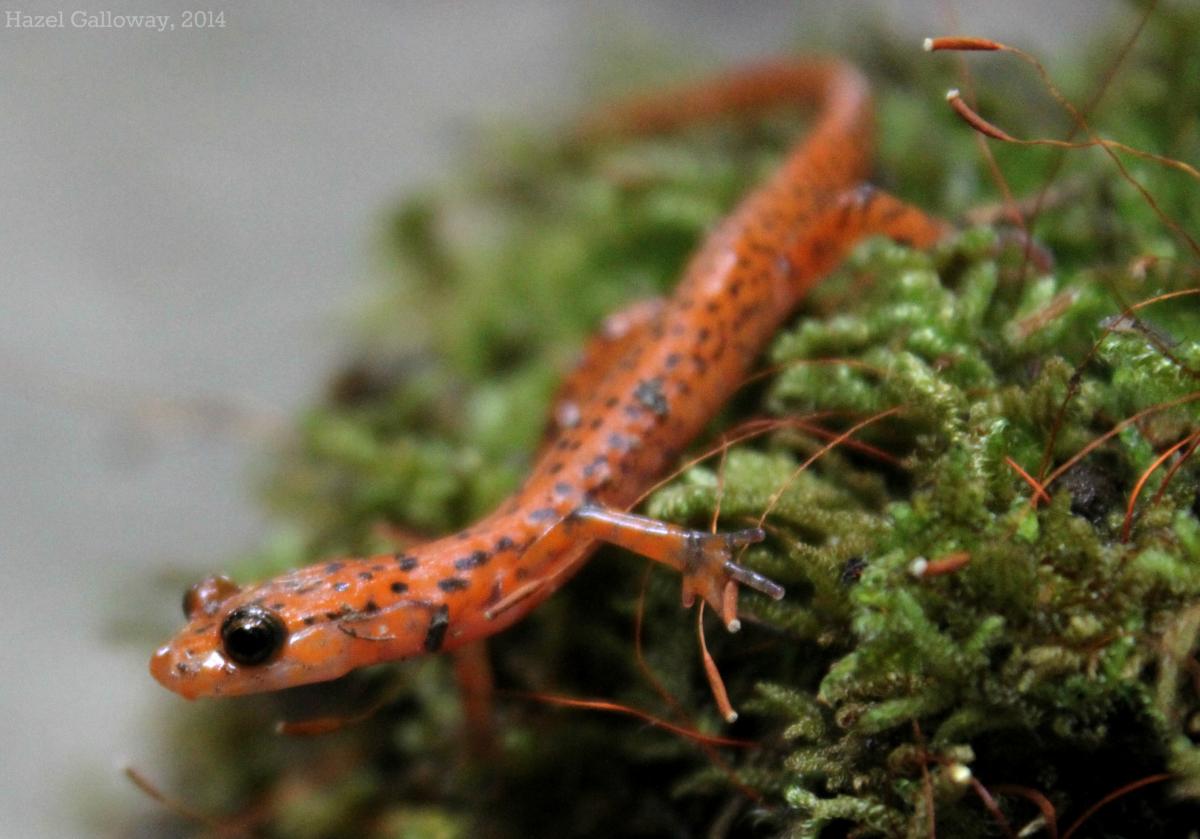 This salamander’s specific name—literally, a fleer (or fugitive) of light—bears witness to its secretive, underground origins. Populations of cave salamanders are found mainly near the mouths of limestone caves and ravines, where they are born in the deepest recesses of underground streams and springs. One researcher searching for E. lucifuga eggs in a Missouri cave found them “attached singly to the bottoms and sides of submerged rocks” about 1 m. from where the spring emerged from the cave wall, 245 m. inside the cave. Although the adults forsake the water and can be found considerable distances away from their cave of origin, females return to the deep springs and pools to lay anywhere from 5 to 120 eggs either attached or freely resting at the bottom of still water. Breeding season seems to vary from September to February, although the exact time depends on the population.
This salamander’s specific name—literally, a fleer (or fugitive) of light—bears witness to its secretive, underground origins. Populations of cave salamanders are found mainly near the mouths of limestone caves and ravines, where they are born in the deepest recesses of underground streams and springs. One researcher searching for E. lucifuga eggs in a Missouri cave found them “attached singly to the bottoms and sides of submerged rocks” about 1 m. from where the spring emerged from the cave wall, 245 m. inside the cave. Although the adults forsake the water and can be found considerable distances away from their cave of origin, females return to the deep springs and pools to lay anywhere from 5 to 120 eggs either attached or freely resting at the bottom of still water. Breeding season seems to vary from September to February, although the exact time depends on the population.
Little is known about development in this species. When the larvae emerge, they are less than two centimeters in length, gilled, and have a broad tail fin. It is likely that they spend 12-15 months as aquatic larvae, consuming a wide variety of the aquatic invertebrates that share their subterranean haunts. By the time they metamorphose, they still measure only 35-40 mm. (excluding the tail). As adults, they lose their tail fin and gills, and switch to the absorption of oxygen through their skin like all plethodontid adults. As a result, they are restricted to moist areas in their habitats. The adults are typically found in the twilight zones of caves, where they use their long limbs, flat toes, and prehensile tails to scale rocks and ledges. However, they can be found under cover objects up to 1 km. outside the mouth of the cave, as well as deeper inside. Additionally, populations have been observed in areas such as Hamilton County, Ohio, that completely lack the limestone caves the salamanders are usually associated with. In these cases, they occur in areas with forested limestone ravines, at least some of which appear to have subsurface water flow.
The mature adults, usually measuring 10-20 cm in total length,  are unusually slender salamanders with long limbs and tails. They can vary in color from dull yellow to bright red-orange, irregularly spotted with dark spots. Younger salamanders tend to be a yellower in color and to have shorter tails than the adults.
are unusually slender salamanders with long limbs and tails. They can vary in color from dull yellow to bright red-orange, irregularly spotted with dark spots. Younger salamanders tend to be a yellower in color and to have shorter tails than the adults.
Like most plethodontids, cave salamanders can release a noxious substance from skin glands when threatened. To further protect themselves against predators, cave salamanders are known to curl up into a ball, raising and undulating their tail over their head to direct the attention of the predator. E. D. Brodie, Jr. found that in tests involving cave salamanders and short-tailed shrews, 12 of 13 attacks resulted bites to the salamander’s tail, after which the shrew would retreat, wiping its mouth and affording its would-be prey an opportunity to escape. In some populations, the percentage of individuals with broken or regenerating tails, likely relics of recent predation attempts, was as high as 59.5%.
This individual was collected near the mouth of Smokehole cave by the field herpetology class on Wednesday night.
Hazel Galloway
Sources:



